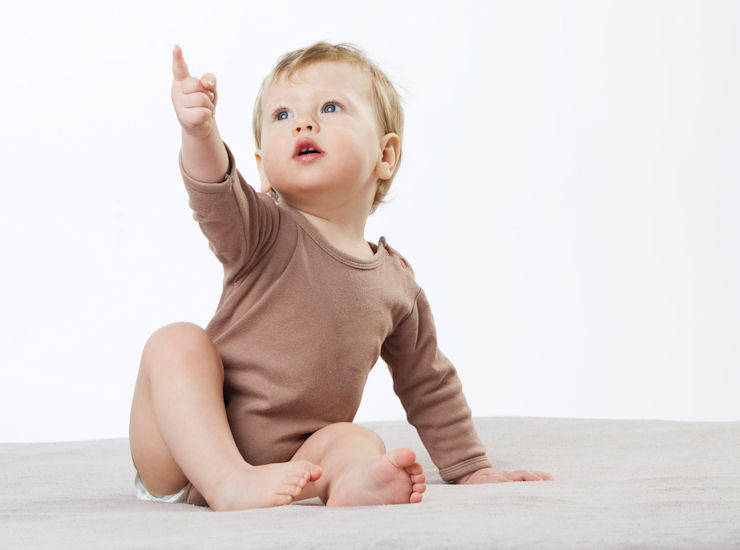
Infants are naturally curious. They love to explore the world around them either in order to help them achieve goals or just to see whether a toy tastes as good as it looks. This inner drive to explore for exploring’s sake is hard to explain as there is seemingly little motivation for infants to do this –why would they want to spend time learning useless information that they are unable to use to accomplish a goal?1 Research has suggested that the brain actually gives infants internal rewards for the acquisition of knowledge, which, in turn, drives children to seek out all sorts of new information, a function which is thought to have been a product of evolution – the more we know, the better we are at surviving!
It’s unclear, though, exactly how infants go about viewing things in their environment and why they might choose to play with one toy over the other. One thought is that the perceived complexity of objects will determine whether or not an infant will want to look at it, with this being a way for infants to be economical with their attention.2, 3 They don’t want to waste their precious time with things that are too complicated for them, whilst they also don’t want to be bored with things that are too easy and so tend to seek out those that are just right, as Goldilocks did. Known as the “Goldilocks” effect, this effect is thought to emerge from the way in which infants efficiently explore their immediate environment – and has even been shown to be the best way for computers and robots to learn!4
In order to explore the Goldilocks effect in early learning, we created a study to examine how 12-month-old infants chose to explore their visual scene. We were interested in how what an infant looks at now affects what they look at next – do they look at the next most difficult or next simplest thing? We decided to explore this idea in a looking time experiment in which we showed infants pictures on a computer screen. We designed stimuli incorporating systematic differences so that we could measure the difference in complexity between subsequent pictures. To create our stimuli we created two novel shapes that differed in shape and colour. We morphed these two shapes together and took screenshots at different stages of this morphing. This resulted a continuum of five shapes A-E that differed systematically in shape and colour. For example, the difference between shapes A and B was small: A is short, wide and blue, while B was slightly taller and thinner and indigo. In contrast, the difference between shapes A and E was pronounced, with E much narrower, shorter and bright red. We used the difference between the shapes as a measure of the complexity of infants’ learning environment.
Earlier work suggests that the relative complexity of stimulus depends on the what children already know; for example, a picture of a cat might be complex to an infant who had no cats at home, but simple to a child with pets.5
To track the effect of learning about one stimulus on infants’ interaction with subsequent stimuli, we presented our shapes in different combinations; the complexity of each shape on a given presentation would therefore be entirely dependant on which shape they saw in the previous presentation. We then recorded where and for how long infants looked, and calculated the complexity of the stimulus sequences infants generated.
Based on our existing work we expect to find a Goldilocks effect6 by which infants generate sequences of intermediate complexity. More generally, though, this research is fascinating as it opens up new avenues for further studies and has huge potential for practical applications. Most importantly, if we possess a greater understanding of how infants best acquire knowledge then we can adapt learning environments to be appropriate for certain age groups in order to maximise learning.
Details of related studies can be found by entering the following titles in to Google Scholar (www.scholar.google.com)
1 Gottlieb, J., Oudeyer, P., Lopes, M., & Baranes, A. (2013). Information-seeking, curiosity, and attention: computational and neural mechanisms. Trends in Cognitive Sciences, 17(11), 585-593.
2 Kidd, C., Piantadosi, S. T., & Aslin, R. N. (2012). The goldilocks effect: Human infants allocate attention to visual sequences that are neither too simple nor too complex. PLoS ONE, 7(5), 1-8.
3 Kidd, C., Piantadosi, S. T., & Aslin, R. N. (2014). The Goldilocks effect in infant auditory attention. Child Development, 85(5), 1795–1804.
4 Oudeyer, P.-Y., & Kaplan, F. (2007). What is intrinsic motivation? a typology of computational approaches. Frontiers in Neurorobotics, 1.
5 Kovack-Lesh, K. A., McMurray, B., & Oakes, L. M. (2014). Four-month-old infants’ visual investigation of cats and dogs: Relations with pet experience and attentional strategy. Developmental Psychology, 50(2), 402–413.
6 Twomey, K. E., & Westermann, G. A neural network model of curiosity-driven infant categorization. Manuscript in preparation.

